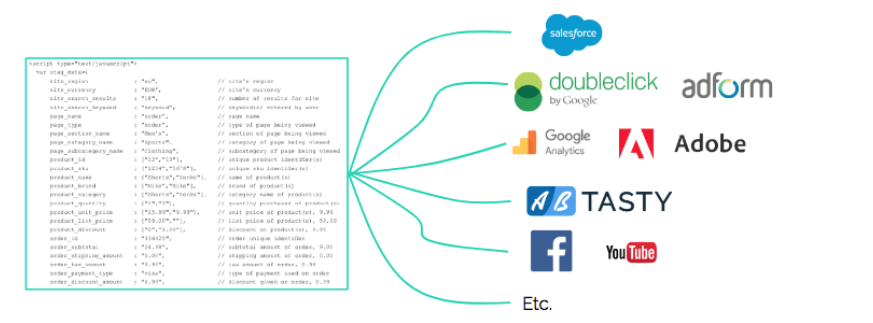video
- Get link
- X
- Other Apps
- Get link
- X
- Other Apps
The concept “datalayer” is usually presented as the enabler to implement a lot of digital advertising/analytics projects. But datalayers stay unclear for many actors.
This article will introduce the datalayer by explaining simply what it is, the business advantages and the state of mind to adopt in order to successfully launch a project involving a datalayer.
Conceptually, a datalayer is a data structure which enables you to organise data to reach business requirements and goals. In other words, a datalayer is a bridge between website data and tags implemented on your website. This structure will contain all custom data that you want to process from your website, for example, to other applications like analytics tools or marketing platforms.
Concretely, a datalayer is a JavaScript object that allows to capture, contextualize and track information provided by users and their behaviour within a website and leverage it in analytics environment, advertising platforms (amongst others) or any other tool. For instance, linking a datalayer with Google analytics enables to store data as custom dimensions, metrics or ecommerce data.
In the illustration below, you can find an example of platforms that can benefit from the usage of a datalayer.

This means the objective of datalayers could be larger, and advertising is only one of the aspects benefiting from this exercise.
The definition of a datalayer, exposed earlier, is mainly technical. But its business objectives are its main strength.
Below, the 4 main business objectives are highlighted:
Smarter business decisions by learning the understanding the revenue generated by each product through eCommerce.
The old way of using variables is to directly hardcode a tag into the code of your website. This means each expansion needs code modification which is extremely constraining and time consuming. While a datalayer combined with a tag manager system enables to leverage your datalayer by enriching tags. In this perspective, one should use a datalayer because of :
We now all agree on the necessity of a datalayer but the management of this project is more sensible. Indeed, this project is engaging a lot of players between developers and marketers.
Marketers, analysts, executives and communication professionals need to draft the business requirements and goals that will be satisfied by data collection methods. A datalayer implementation represents an intense collaboration between advertisers, agency and IT which can take longer than expected. A good communication between developers and marketers are thus crucial. Especially knowing that those 2 entities have highly different languages.
A way to lead this project to a success is to develop a governance model. This blueprint should clearly describe:
Finally it is crucial to treat the datalayer as a living entity. Datalayer retrieves data that could be used by many different tools, users and stakeholders. This data structure is an entry point of amazing future projects. Its structure and objectives should be challenged, able to evolve and deployed/reused for other products for instance.
Implementing a datalayer is the means of launching a lot of projects. As we have seen earlier, a datalayer could be compared to a standard interface between backend and digital tools. But it is crucial to keep in mind the final objective and not fall in the common pitfalls. Indeed in practice, the potential of a datalayer is usually not exploited in Belgium: often not put in place correctly or when in place, not well documented of governed.
Comments
Post a Comment